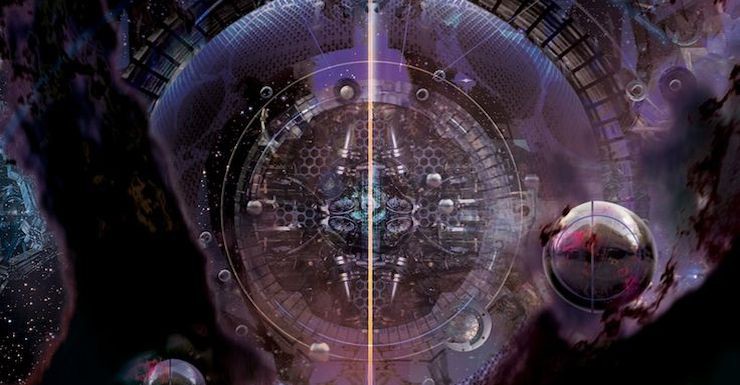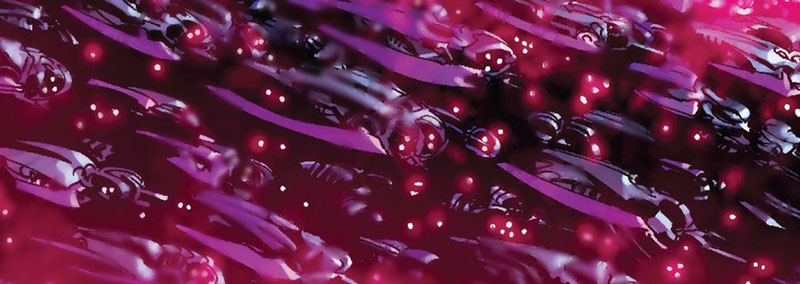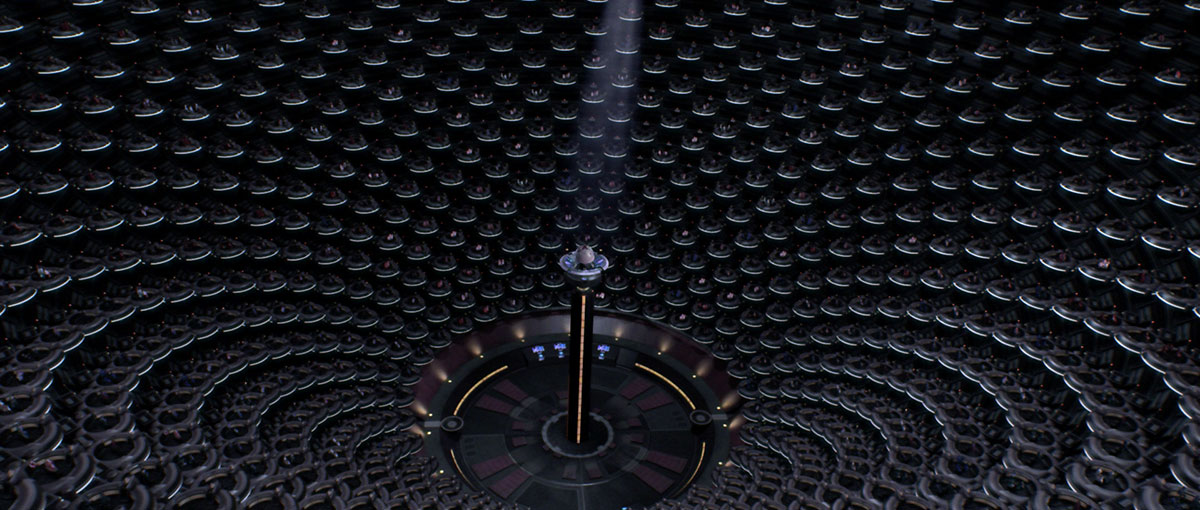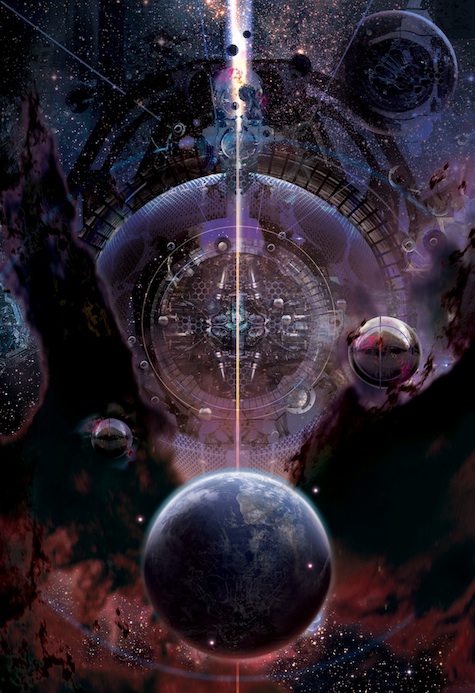Time for some Real Talk: Cixin Liu’s Three-Body Problem trilogy has trouble presenting non-stereotypical characters but I CAN’T STOP READING IT and that’s because it takes all these great theories about physics and the universe and threads them together into a fantastically epic story that determines the course of all humanity. It’s like someone wrote fanfic based on I Fucking Love Science and it’s GREAT. And knowing just one thing ahead of time makes it that great.
(Mild spoilers for Cixin Liu’s The Three-Body Problem ahead.)
For the trilogy, the second book of which arrives on English-speaking shores on August 11th, to have real oomph for you as the interested reader, you should familiarize yourself with the Fermi Paradox. Because the Fermi Paradox is the kind of theory that sparks defiance deep within your imagination. As if the universe itself were a cackling villain trapping you in a shark tank, unaware that you, in full James Bond mode, are more than capable of escaping without a scratch. (You’ve failed again, universe! Humanity will return in Die Another Day.)
To understand the Fermi Paradox we first need to review the Drake Equation, a thought experiment that estimates how much intelligent life there is for us to communicate with in the Milky Way Galaxy.
Here it is:
 MATH ALERT. Except not really. The above variables can be expressed in a form almost like a poem.
MATH ALERT. Except not really. The above variables can be expressed in a form almost like a poem.
- N* equals the average rate of star formation in our galaxy.
- fp equals the fraction of those stars that have planets.
- no equals the average number of planets that can potentially support life per star that has planets.
- fl equals the fraction of planets that could support life that actually develop life at some point.
- fi equals the fraction of planets with life that actually go on to develop intelligent life (civilizations).
- fc equals the fraction of civilizations that develop a technology that releases detectable signs of their existence into space.
- fl equals the length of time for which such civilizations release detectable signals into space.
If this is still too much, just listen to Carl Sagan croon about it in his sweet mellow tenor. (Carl Sagan, the woodwind of the universe, the University of Chicago swing choir called him.) The clip is only 8 minutes.
As Sagan mentions, we know the figure at the very top of this list, and we can plug in reasonably accurate numbers for entries 2, 3, and 4 thanks to these incessant explorations. The rest is simply guessing, but as Sagan points out, even the numerical range that these guesses produces still results in a very large number of intelligent communicative civilizations present within the galaxy. The latest estimates depict a low of only two civilizations and a high of 280 million civilizations. Imagine how many times you’ve stumbled across a comment lambasting George R. R. Martin to “get back to writing!” and you have an idea of how often intelligent civilizations arise in the galaxy.
But judging solely by how no one ever shows up to my aliens-only birthday parties, humanity hasn’t met any alien civilizations. We haven’t even found any evidence of them. Or even peered through a window at their high school prom nights while quietly mouthing along to “Endless Love.” Despite our pseudo-scientific Drake Equation thought experiment, we are still alone in the cosmos.
This contradiction is essentially what the Fermi Paradox is. Our reasoning calls for a galaxy teeming with communicative civilizations but the physical evidence before us shows no trace of those civilizations. The Fermi Paradox isn’t solely a response to the Drake Equation. It’s also a response to Enrico Fermi’s own reasoning regarding the presence of galactic civilizations. Because even if you limit interstellar travel to generation ships traveling at conventional speeds, Fermi reasoned, it would still only take less than one hundred million years to colonize the entire galaxy. Earth has been an ideally habitable planet for many times that length, so why no colonization?
This is the paradox of alien life, and Cixin Liu’s Three-Body Problem trilogy attempts to answer this paradox in a few ways. In the first book, The Three-Body Problem, that answer is very, very direct. There’s an alien civilization literally just one star over, only 4.3 light years away on Proxima Centauri, on a planet orbiting a three-starred system. We discover them and they discover us only when both of our civilizations pass a technological threshold (interstellar radio communication).
Further, The Three-Body Problem goes to some fantastic lengths to sketch out how tenacious intelligent and communicative civilizations can be. (Seriously, read this one chapter describing the aliens’ homeworld. It is sick.) The Trisolarans, as they’re known in Liu’s trilogy, not only develop an intelligent civilization once, they’re forced to do it over and over and over and over thanks to the random nature of their planet’s orbit. The three suns in their star system wreak havoc on the Trisolaran planet, sometimes burning it clean with solar flame, sometimes abandoning it for icy eons. And because of the random nature of their three suns, these destructive periods are completely unpredictable. Their civilization suffers from the extreme nature of a three-body problem.
The “three body problem” is a real mathematical issue; a devilishly simple situation that creates endless complexity. Imagine two gravitational bodies. It’s fairly simple to predict how those two bodies will react to each other. But once you introduce a third body the gravitational balance between those three bodies shifts constantly and it becomes extremely difficult to predict where each of the three bodies will go for more than a short length of time.
Here’s a simple depiction of how wacky it gets. Imagine an unseen planet orbiting the stable blue “star.”
BLAMMO! Even though the planet is orbiting the star with the most stable path, the yellow star still finds its way over eventually thanks to that distant red star, bumping the planet out of its orbit, searing its surface, or even destroying it altogether. Keep in mind that the movement of the above “stars” is actually an ideal and predictable three-body problem, as the paths of the blue and red stars remain stable. So even in this “stable” model, a civilization living in this star system would still need to start over at least once and still would only have a brief warning before the next civilization-destroying cataclysm. The Trisolarans’ alien civilization do not benefit from this “ideal” version of the three-body problem.
Through this example, Liu’s The Three-Body Problem posits that life in our galaxy would not only be able to survive random cataclysms, but that alien life would be able to sustain or redevelop its communication technology after said cataclysms. By the start of the second book in the trilogy, The Dark Forest, it has become clear that not only can communicative civilizations survive environments far more harsh than Earth, but that they can develop space-faring and communication technologies far more advanced than our own.
This is one answer to the Fermi Paradox, but there are others, and some of them are really trippy. Here are a few:
1. Aliens are already here, out in the asteroid belt. But they’re self-replicating machines and not interested in contact.
One of the ways the galaxy could be colonized in only a few million years is if a race constructed a fleet of Von Neumann probes. Theorized by awesomely-named physicist John von Neumann (“Just call me John…von Neumann.”), a Von Neumann probe is a machine capable of self-replication. A probe could be launched from an alien world and travel at conventional speeds for thousands upon millions of years to the next star system. Once there, it would carry out instructions to mine raw materials (from a solar system’s asteroid belt, for instance) and construct a factory that could produce replicas of itself. These replicas could launch themselves to every surrounding star system and repeat the process, over and over, until the entire galaxy is colonized.
Von Neumann probes would be an excellent way to map the contents of a galaxy without faster-than-light technology, each probe heading to a solar system and sending reports back to the homeworld on that the system’s make-up and inhabitants. A Von Neumann probe would most likely eschew active contact with lifeforms to avoid contamination or destruction.
So far, we haven’t found any evidence that our solar system or asteroid belt have been visited by Von Neumann probes, but we also haven’t taken a close look at our asteroid belt or the other bodies in our solar system. For all we know, we’ve been visited thousands of times by observation-only probes. For all we know, that’s what Fitbits really are.
2. Galactus.
Obviously, this is a more loony, fictional answer to the Fermi Paradox, but it’s still possible. For those not familiar with Galactus (and shame on you) he’s a Marvel character who eats entire planets in order to sustain his gargantuan cosmic presence. In the Marvel Universe he was turned away by the Fantastic Four in a now-legendary storyline. But in our universe? Well… I doubt that anyone on our Earth has an effective plan for convincing a semi-pantsless god to not eat the planet.
While it’s unlikely that a singular being with a fabulous hat is destroying alien civilizations one after the other, this remains a realistic answer to the Fermi Paradox. What if there’s a fleet of Von Neumann probes out there with orders to pre-colonize life-sustaining worlds for a forthcoming alien civilization? What if there’s a force or civilization of sufficient strength and reach that is actively wiping out civilizations before they can grow to be a threat? It’s far-fetched, but it’s not impossible. It’s a bleak thought, for sure. It means that to look up at the sky is to look out upon an interstellar graveyard. And that at some point we’ll be next.
3. We’re not sciencing hard enough.
We’re getting better and better at analyzing our solar system and the surrounding universe, but we’re still groping around in the dark. Hell, we only got clear, detailed HD footage of our closest neighboring planet three years ago and we still can’t see exoplanets; we deduce their presence by how much they make their parent star dim and wobble. We’re still probing the limits of life-sustaining environments through exploration of Earthbound extremophiles. SETI can’t detect extraterrestrial signals sent our way in datastream form, or in powerful gamma ray frequencies, both of which are likely options for an advanced communicative civilizations that wants to focus a ton of non-degraded data onto our planet. In many ways, our asking where all the aliens are is like facing the floor in a bookstore and asking where all the books went. Just because we don’t see or hear them right now doesn’t mean they’re not there.
4. The galaxy is too boring to explore.
Why bother contacting aliens, or even looking for them, when there are so many worlds and alien life (or at least alien thinking) contained here on Earth? Monitoring and putting things into space is an expensive and time-consuming process and it’s possible that once civilizations get to a certain point it becomes more economic, or resources become too scarce, or it becomes more appealing to explore different modes of artificial reality. Humanity has taken large strides in that regard in the past few decades. Hundreds of years ago we began containing worlds within books. Decades ago we began containing worlds within movies and television, and a generation ago we began containing worlds within video games and the internet. We show no signs of stopping. Minecraft can procedurally generate 8 times the surface of the Earth and is available for $15. Facebook, Microsoft, and Google are falling over themselves to introduce virtual reality that can seal you off from the “real” world. One upcoming Playstation 4 video game, No Man’s Sky, is capable of automatically generating quintillions of alien worlds. Exploring it fully would take half a trillion years.
Considering the continuing development of artificial intelligence, it stands to reason that the next one hundred years of humanity’s development could see procedurally generated virtual universes that develop free-thinking artificial intelligences within them. These worlds would develop on their own and be just as alien as anything we could find out in the galaxy. They’d be cheaper and safer to explore, too. (There is no respawning out in realspace.) For all we know, artificial intelligence within a procedurally generated universe is what we are.
It could take only a small number of civilizations choosing internal exploration over external exploration for the galaxy to feel “quiet,” too. A communicative civilization must be broadcasting/evident in the same window of time as we’re listening and looking in order for us to detect each other. The Earth has been around for 5 billion years, and we’ve only been communicative for a century of that time, so these windows may be very small and overlap may be rare. So if our window of communication only lines up with two other civilizations at the moment, and one of them has chosen internal exploration, then that cuts our chances of discovering an alien civilization by fully half!
5. Do not feed the Earth.
Let’s go visit the other extreme in our quest to answer the Fermi Paradox. Let’s imagine that not only are there lots of communicative civilizations out there but that they’ve networked themselves into a functional organization/empire/federation/whatever.
Any galactic organization of such size would need to be able to transmit information and supplies faster-than-light, so the odds are that they would have a good understanding of which star systems contain which civilizations, plus what level of development those civilizations are at. It also stands to reason that they have humanitarian or defense-focused initiatives that necessitate leaving a civilization alone until it reaches a “safe” stage of development. Maybe Earth will get a call from this organization once we figure out how to eliminate war and poverty. Or maybe Earth will be contacted once it’s been determined that the shock of meeting another culture won’t destroy our own culture. Maybe we’ll get a stern “NOOOOPE.” if we don’t figure out how to be non-destructive but deduce FTL travel anyhow.
There would be no way to detect this kind of galactic organization. Spaceships are impossible for us to spot at distance with current telescopic technology. We can’t even train telescopes on our own probes, like Voyager 1 and 2, even though we know their path through space. It’s a resolution over distance issue. The farther out a craft travels the more space a telescope has to search to pinpoint that craft. Since the craft is constantly moving, we can’t search space quickly enough to pinpoint it.
You can prove this for yourself right now! I made one pixel of the below Star Wars Senate picture much brighter than the pixels around it. See if you can find it.
If you found it, well, bad news, the pixel/spacecraft has already moved away in the time it took you to locate it. This is even more impossible task if the pixel/spacecraft can travel faster-than-light, since that is faster than information about the craft’s location can reach us.
Basically, we might be zoo-ed off from the rest of galactic civilization and we’d have no way of knowing it. And none of our finest original Netflix programs would be enough to persuade this galactic conglomeration into contacting us! (Probably. Unbreakable Kimmy Schmidt is pretty great.)
6. What happens in The Dark Forest.
Cixin Liu’s The Three-Body Problem provides a massive answer to the Fermi Paradox, but the trilogy doesn’t stop there. The Dark Forest has another take on the issue, one that is terrifically unique and utterly chilling.
Once I read it, the answer also surprisingly filled me with hope for humanity. Not only will we figure out how to eliminate the Fermi Paradox, I thought, but we’ll do it in a way that no other civilization has been capable of doing!
This is the overriding thought that Cixin Liu leaves his readers in The Dark Forest. As intelligent lifeforms, we may not be rare, but we’re still special.
Chris Lough is the nebulous snark cloud of Tor.com. You can read his writing here or sparsely attend him on Twitter.

















